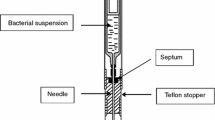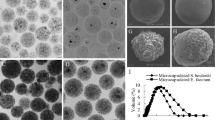Abstract
In a majority of environments, microbes live as interacting communities. Microbial communities are composed of a mix of microbes with often unknown functions. Polymicrobial diseases represent the clinical and pathological manifestations induced by the presence of multiple infectious agents. These diseases are difficult to diagnose and treat and usually are more severe than monomicrobial infections. The interaction relationship between Enterococcus faecalis and Escherichia coli was researched using a Calvet calorimeter. Three mixtures of both bacteria were prepared in the following proportions: 20 + 80 % (0.2 mL E. faecalis + 0.8 mL E. coli), 50 + 50 % (0.5 mL E. faecalis + 0.5 mL E. coli) and 80 + 20 % (0.8 mL E. faecalis + 0.2 mL E. coli). Experiments were carried out at concentration of 106 CFU mL−1 and a constant temperature of 309.65 K. The differences in shape of graph of E. faecalis, E. coli and their mixtures were compared. Also, the thermokinetic parameters such as detection time (t d), growth constant (k), generation time (G) and the amount of heat released (Q) were calculated.



Similar content being viewed by others
References
Pepper IL, Gerba CP, Gentry TJ. Environmental microbiology. 3rd ed. Amsterdam: Academic Press; 2015.
Ausina RV, Moreno GS. Tratado SEIMC de Enfermedades Infecciosas y Microbiología Clínica. 1st ed. Madrid: Médica Panamericana; 2006.
Murray JL, Connell JL, Stacy A, Turner KH, Whiteley M. Mechanisms of synergy in polymicrobial infections. J Microbiol. 2014;52(3):188–99.
Brogden KA, Guthmiller JM. Polymicrobial diseases. Washington (DC): ASM Press; 2002.
Pavlović M, Nikolić J. Antimicrobial treatment of polymicrobial infections. Med Pregl. 2010;63(Suppl 1):37–46.
Brogden KA, Guthmiller JM, Taylor CE. Human polymicrobial infections. Lancet. 2005;365(9455):253–5.
Peters BM, Jabra-Rizk MA, O’May GA, Costerton JW, Shirtliff ME. Polymicrobial interactions: impact on pathogenesis and human disease. Clin Microbiol. 2012;25(1):193–213.
Dalton T, Dowd SE, Wolcott RD, Sun Y, Watters C, Griswold JA, Rumbaugh KP. An in vivo polymicrobial biofilm wound infection model to study interspecies interactions. PLoS One. 2011;6(11):e27317.
Mastropaolo MD, Evans NP, Byrnes MK, Stevens AM, Robertson JL, Melville SB. Synergy in polymicrobial infections in a mouse model of type 2 diabetes. Infect Immun. 2005;73(9):6055–63.
Bakaletz LO. Developing animal models for polymicrobial diseases. Nat Rev Microbiol. 2004;2(7):552–68.
Watrous J, Roach P, Alexandrov T, Heath BS, Yang JY, Kersten RD, et al. Mass spectral molecular networking of living microbial colonies. Proc Natl Acad Sci USA. 2012;109(26):E1743–52.
Yang JY, Phelan VV, Simkovsky R, Watrous JD, Trial RM, Fleming TC, et al. Primer on agar-based microbial imaging mass spectrometry. J Bacteriol. 2012;194(22):6023–8.
Wessel AK, Hmelo L, Parsek MR, Whiteley M. Going local: technologies for exploring bacterial microenvironments. Nat Rev Microbiol. 2013;11(5):337–48.
Prescott LM, Harley JP, Klein DA. Microbiology. 5th ed. New York: Mc Graw Hill; 2004.
Greenwood D, Slack R, Peutherer J, Barer M. Medical microbiology: a guide to microbial infections: pathogenesis, immunity, laboratory diagnosis, and control. 17th ed. Edinburgh: Churchill Livingstone/Elsevier; 2007.
Braissant O, Wirz D, Göpfert B, Daniels AU. Use of isothermal microcalorimetry to monitor microbial activities. FEMS Microbiol Lett. 2010;303:1–8.
Lago N, Legido JL, Paz-Andrade MI, Arias I, Casás LM. Microcalorimetric study of the growth and metabolism of Pseudomonas aeruginosa. J Therm Anal Calorim. 2011;105:651–5.
Tan MR, Ren YS, Yan D, Meng XH, Cheng LH, Ll Qiu, et al. Detection of microorganisms in different states based on microcalorimetry. J Therm Anal Calorim. 2012;109(2):1069–75.
Zaharia DC, Iancu C, Steriade AT, Muntean AA, Balint O, Popa VT, et al. MicroDSC study of Staphylococcus epidermidis growth. BMC Microbiol. 2010;10:322.
Rivero NL, Soto JLL, Casás LM, Santos IA. Microcalorimetric study of the growth of Enterococcus faecalis in an enriched culture medium. J Therm Anal Calorim. 2012;108(2):665–70.
Rivero NL, Legido JL, Santos IA, Casás LM. Comparative study of microcalorimetric behavior of Escherichia coli, Proteus mirabilis and Klebsiella pneumoniae. Pol J Microbiol. 2012;61(3):199–204.
Bonkat G, Bachman A, Solokhina A, Widmer AF, Frei R, Gasser T, et al. Growth of mycobacteria in urine determined by isothermal microcalorimetry: implications for urogenital tuberculosis and other mycobacterial infections. Urology. 2012;80(5):1163e9–12.
Bonkat G, Braissant O, Malte R, Solokhina A, Widmer AF, Frei R, et al. Standardization of isothermal microcalorimetry in urinary tract detection by using artificial urine. World J Urol. 2013;31(3):553–7.
Kong W-J, Xing X-Y, Xiao XH, Zhao Y-L, Wei J-H, Wang JB, et al. Effect of berberine on Escherichia coli, Bacillus subtilis, and their mixtures as determined by isothermal microcalorimetry. Appl Microbiol Biotechnol. 2012;96:503–10.
Vázquez C, Lago N, Legido JL, Arias I, Casás LM, Mato MM. Microcalorimetric study of the growth of Enterococcus faecalis, Klebsiella pneumoniae and their mixtures in an enriched culture medium. J Therm Anal Calorim. 2013;113(3):1415–20.
Vázquez C, Lago N, Mato MM, Casás LM, Esarte L, Legido JL, et al. Microcalorimetric performance of the growth in culture of Escherichia coli, Proteus mirabilis and their mixtures in different proportions. J Therm Anal Calorim. 2014;116(1):107–12.
Wang F, Yao J, Yu C, Chen H, Yi Z. Investigating Pseudomonas putida-Candida humicola interactions as affected by chelate fe(III) in soil. Bull Environ Contam Toxicol. 2014;92(3):358–63.
Vázquez C, Lago N, Mato MM, Legido JL, Esarte L. Microcalorimetric study of the growth of Enterococcus faecalis, Pseudomonas aeruginosa and their mixtures in an enriched culture medium. J Therm Anal Calorim. 2015;121(1):463–8.
Murray PR, Rosenthal KS, Pfaller MA. Medical microbiology. 7th ed. Philadelphia: Elsevier Saunders; 2013.
Verdes PV, Mato MM, Paz Andrade MI, Legido JL. Contribution to study of the thermodynamics properties of mixtures containing 2-methoxy-2-methylpropane, alkanol, alkane. J Chem Therm. 2014;73:224–31.
Ma J, Qi WT, Yang LN, Yu WT, Xie YB, Wang W, et al. Microcalorimetric study on the growth and metabolism of microencapsulated microbial cell culture. J Microbiol Methods. 2007;68:172–7.
Braissant O, Bonkat G, Wirz D, Bachmann A. Microbial growth and isothermal microcalorimetry: growth models and their application to microcalorimetric data. Thermochim Acta. 2013;555:64–71.
Acknowledgements
We thank María Perfecta Salgado Gonzalez and Sofia Baz Rodríguez for their collaboration with the technical measures. We are also thankful for the financial support provided by the project EM 2012/141 by “Xunta de Galicia” and the project FIS 2011-23322 funded by Ministry of Science and Innovation of Spain. All these projects are co-financed with FEDER funds.
Author information
Authors and Affiliations
Corresponding author
Rights and permissions
About this article
Cite this article
Vazquez, C., Lago, N., Mato, M.M. et al. Study of the growth of Enterococcus faecalis, Escherichia coli and their mixtures by microcalorimetry. J Therm Anal Calorim 125, 739–744 (2016). https://doi.org/10.1007/s10973-015-5203-y
Received:
Accepted:
Published:
Issue Date:
DOI: https://doi.org/10.1007/s10973-015-5203-y




